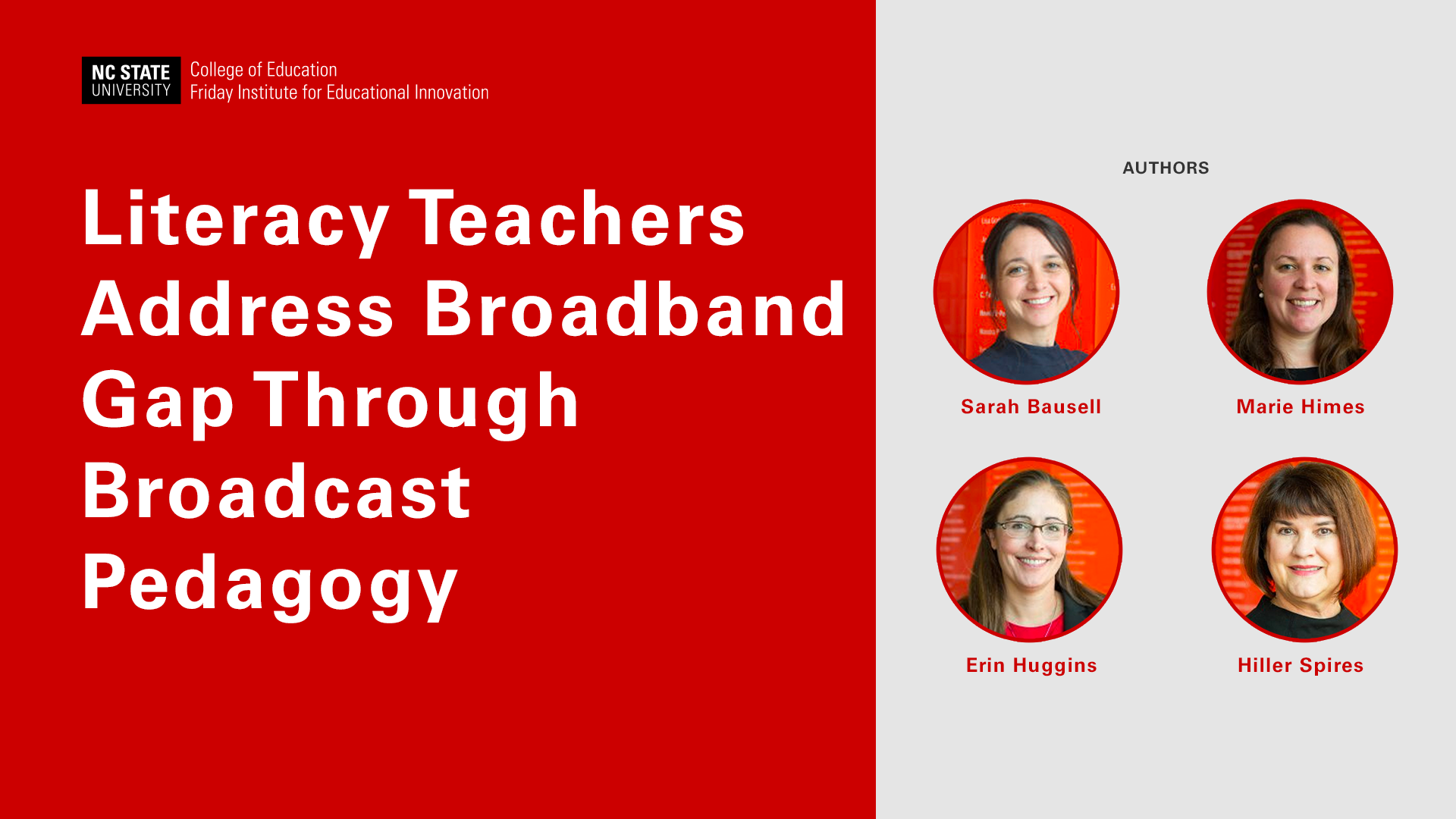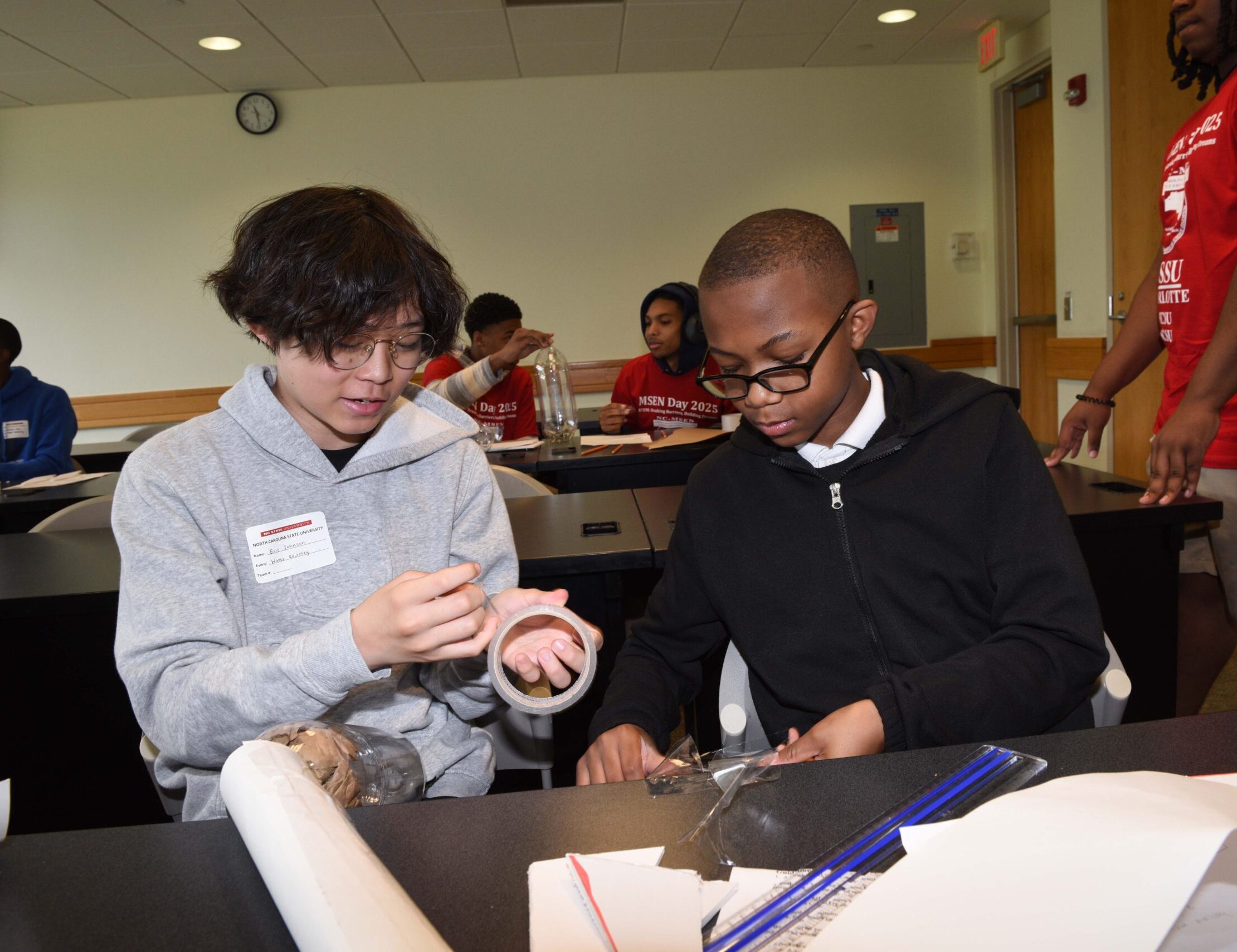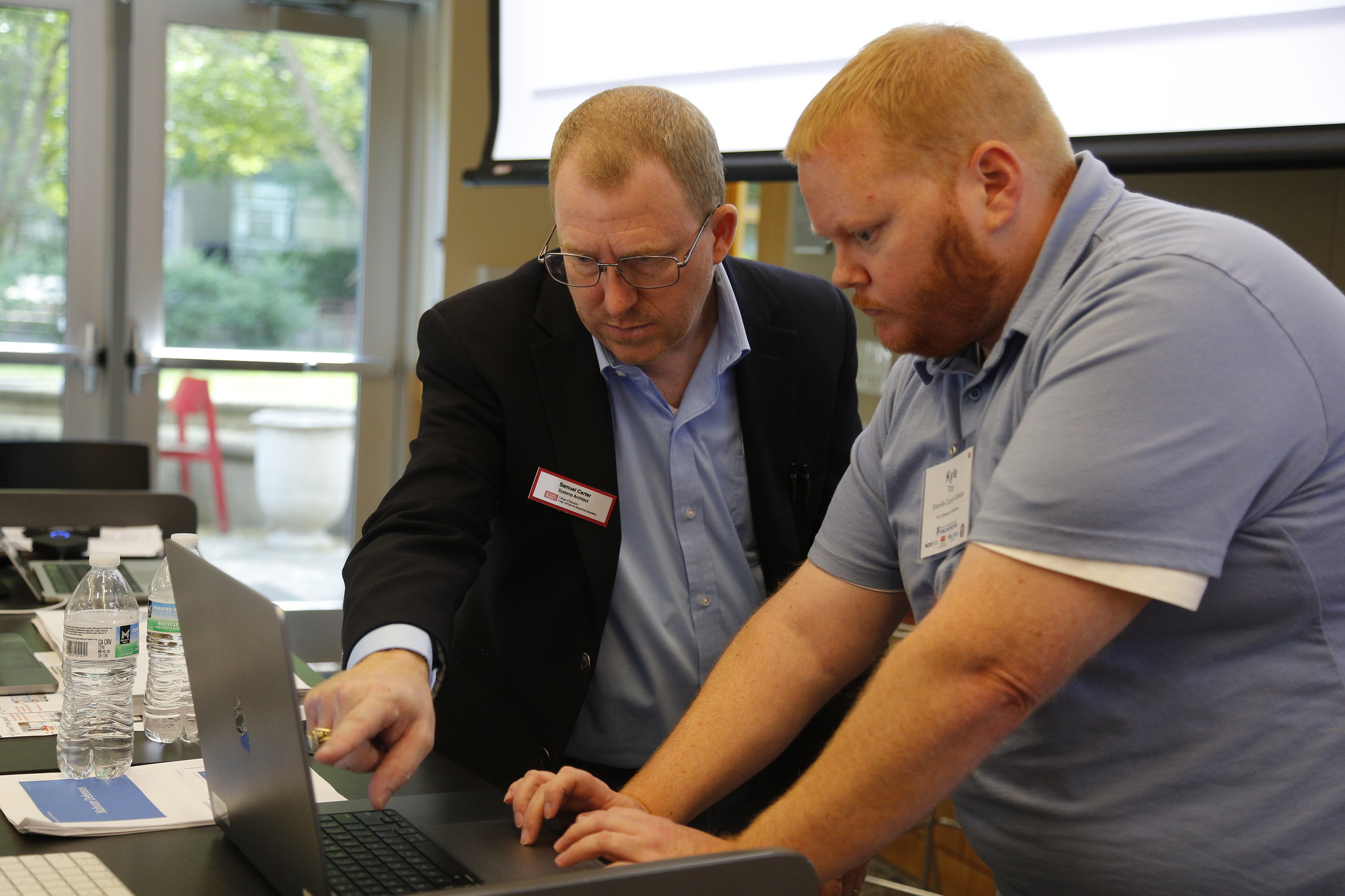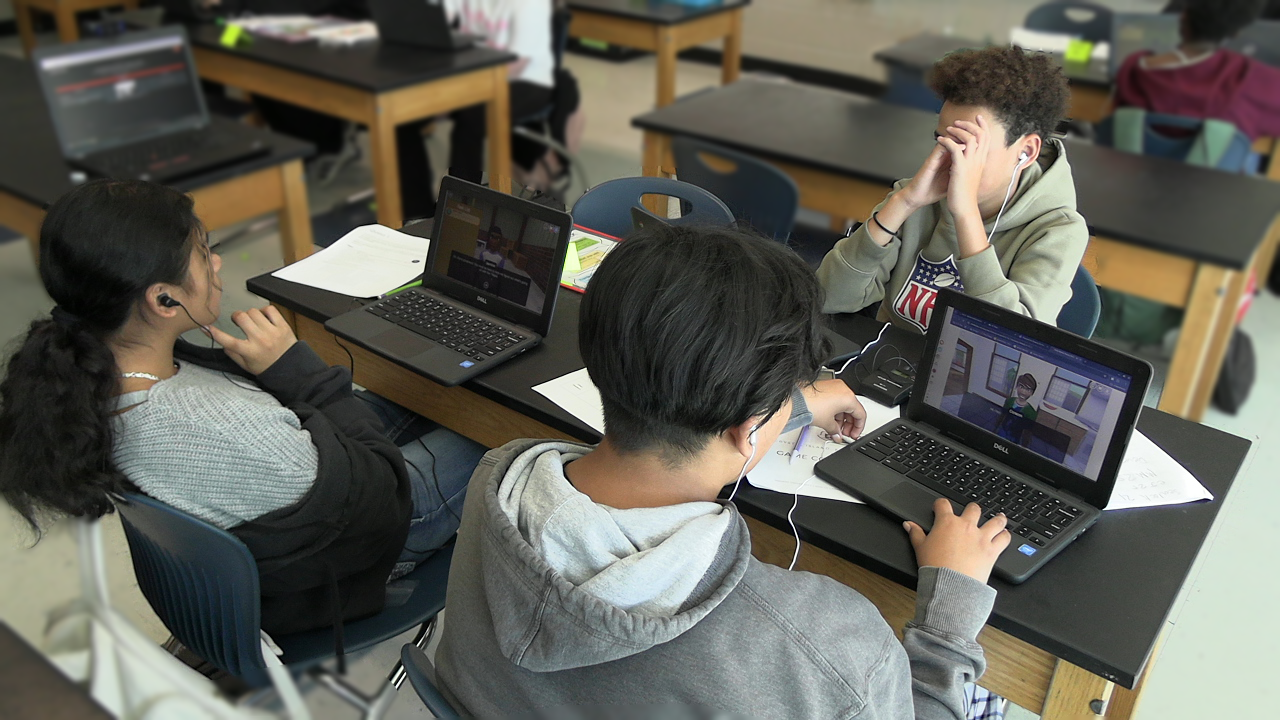New Research on Literacy Teaching Innovations During the COVID-19 Pandemic Highlights Model for Broadcast Pedagogy

A recent research study published by Friday Institute Research Scholar Sarah Bausell, New Literacies Collaborative Director Marie Himes, Associate Director of the Program Evaluation and Education Research (PEER) Group Erin Huggins and Executive Director and Professor Emerita Hiller Spires highlights how literacy classroom instructional approaches can be adapted for television through the concept of broadcast pedagogy.
“Literacy Teachers Address Broadband Gap Through Broadcast Pedagogy”, which was published in The Journal of Literacy and Technology, explores how literacy teachers who were involved in a multi-organizational Community of Practice (CoP) worked together to adapt formal classroom reading instruction for television during COVID-19 emergency remote learning from spring 2020 through early spring 2021 for the At-Home Learning Initiative.
The At-Home Learning Initiative was created to help address remote learning gaps across North Carolina during COVID-19 through television instruction. With funds from the CARES Act, the North Carolina Department of Public Instruction (NCDPI), the Friday Institute for Educational Innovation and PBS NC collaborated with teachers to create and implement 192 literacy and math lessons for Pre-K through fifth grade students. The lessons continue to be featured in PBS North Carolina’s Classroom Connection program, which has a potential audience of over 5.3 million households statewide through free public television.
A team from the Friday Institute recruited 24 Pre-K-5 educators—12 who were literacy-focused and 12 focused on math—through their professional networks to design and film the literacy and mathematics lessons. These educators were grouped in grade-level, content-area teams to formulate cohesive lesson sequences for each lesson series, identifying learning goals and state standards with which to align content.
“As we were conceptualizing the research for the literacy aspect of the project, it was important to situate the work theoretically within the literacy field,” said Bausell. “We used new literacies as a lens to understand teacher adaptation of literacy instruction in an increasingly uncertain and complex world and Communities of Practice as a structure and lens to understand teacher collaboration and innovation.”
By studying seven of the literacy teachers through a yearlong collective case study, the Friday Institute research team answered two questions: 1) What are the components of broadcast pedagogy? and 2) How do teachers perceive the value of innovating through broadcast pedagogy? The team analyzed multiple data sources for the study, including 56 lesson plans, 56 video lessons and seven semi-structured literacy teacher interviews.
The Components of Broadcast Pedagogy
Broadcast pedagogy uses the broadcast medium (e.g., accessible anytime and anywhere, visual and aural enhancements, intentionality in scripting and set design) to teach key grade-level literacy concepts. The research team further defined the concept by identifying four components of broadcast pedagogy: coordinating content, facilitating teacher presence, scripting teacher talk and leveraging post-production affordances.
“I initially coined the term broadcast pedagogy for this project in order to capture the innovative context of the At-Home Learning Initiative in which the teachers were working,” said Spires. “We knew that through our research we needed to define exactly what processes the teachers were innovating as they taught in this unique way. It was exciting to see the four components of broadcast pedagogy come to life as the literacy teachers translated their face-to-face classroom practices for a television audience.”
As a part of coordinating content, the literacy teachers focused on a target literacy skill connected to one of the five pillars of reading (phonemic awareness, phonics, vocabulary, fluency and comprehension), aligned their lessons to the NC Standard Course of Study, highlighted key grade-level concepts that students typically struggle with and incorporated rich, diverse and engaging texts. Facilitating teacher presence was key to broadcast pedagogy because teachers had to learn to act for the camera in order to create engagement with students in the television audience.
One challenge of broadcast pedagogy is learning how to teach without the benefit of student feedback. Scripting teacher talk became essential as teachers created a script for their 10-to-12-minute lessons. Scripts allowed teachers to reach an economy and precision of instructional language before filming and to anticipate meaningful opportunities for gestures (e.g., squat down with short vowel sounds and stand tall for long vowel sounds).
Lastly, the Friday Institute’s collaboration with PBS NC allowed them to leverage post-production affordances including splicing raw footage, adding sound effects and music, and overlaying visual cues and animation to visually and aurally enhance the pedagogical process.
Teachers’ Perception of the Value of Broadcast Pedagogy
For the second research question, teachers perceived that innovating with new literacies allowed them to leverage public television to deliver equitable literacy instruction during the COVID-19 pandemic. Specifically, the data revealed that broadcast pedagogy supported teachers to address instructional equity, extend their sphere of influence and revisit their professional literacy content knowledge.
“Many of the literacy teachers involved in the At-Home Learning Classroom Connection project framed this opportunity as a stretch exercise in terms of effective literacy instructional design and pedagogy,” said Himes. “The adaptations that the teachers made to their instruction for the broadcast medium, in many cases, also prompted them to reflect on and make changes to their in-the-classroom literacy instructional practices.”
Teachers were excited to participate in an initiative that was able to directly address instructional equity. Many of the teachers spoke to the lack of access to broadband internet as a motivator for their participation in the project. Through project participation, teachers were able to extend their sphere of influence, with one of the benefits of the community of practice being a sense of professional connectivity and development of leadership capacities.
Also, teachers were able to revisit their professional literacy content knowledge. At the time of the study, the science of reading, a body of research that emphasizes five pillars of systematic reading instruction—phonemic awareness, phonics, fluency, vocabulary and comprehension—was pervasive in national conversations and gaining significant implementation traction within North Carolina. Participants grappled with evolving expectations of reading instruction and worked to align their broadcast instruction with the science of reading.
Research Implications Beyond North Carolina
Like many other teacher leaders across the country, the teachers in this study were motivated to engage new methods of instruction by unprecedented, pandemic-related student needs. This study belongs to a particular time period (i.e., emergency remote learning), but the implications for pedagogical innovations reach beyond this moment in time.
“This study is a model for teachers who are interested in adapting and innovating with their literacy pedagogy for instructional contexts beyond the classroom,” said Huggins. “It’s also a model for teacher educators as they support teachers in the work of adaptation and innovation and for industry- or community-based organizations who partner with teachers to create and deliver innovative literacy content for young learners through broadcast pedagogy.”
- Categories:


